1965 Mexican Grand Prix race report: Ginther wraps it up
Richie Ginther and Honda took their first ever championship win in Mexico City, the high-altitude conditions favouring the power of the Japanese marque's engine

Honda's Richie Ginther celebrates the win with chief mechanic Yoshio Nakamura.
Motorsport Images
This year’s Mexican Grand Prix contrasted drastically from last year in so far as in the last race for 1964 the Championship was not decided, while far 1965 the Championship had been clinched back in August at the German Grand Prix. Of the three drivers whose fortunes were in the balance until the last lap drama 12 months ago, the champion was unable to return this year as he was still suffering from his Mosport accident.
The 5-kilometre circuit, situated in a multi-purpose sports park, calls for considerable driving skill due to the variety of corners and the changing cambers. It also highlights the mechanical skill of the pit staff, as the over-7,000ft altitude of the vast plain on which Mexico City is built produces mixture and heating problems found at no other Grand Prix circuit.
The entrants were basically as at Watkins Glen, with the substitution of Bondurant by Scarfiotti as the third Ferrari driver. Lotus had three cars for Clark, Spence and Solana (the local Mexican champion). Clark’s car was fitted with a 32-valve Climax V8 rebuilt from the engine which broke at Watkins Glen, and flown out to Mexico. Spence had a 90 crank engine with the high exhaust, while Solana was to drive a 33 with a flat crank engine.
Ferraris were again using all flat-12 engines; two freshly tuned ones had been flown in from Modena, arriving on the Thursday afternoon, for Bandini’s car. Scarfiotti was the other team entry from Ferrari, while Rodriguez was officially entered by North American Racing Team, and had a blue and white stripe painted down the centre of his car. While the Ferrari mechanics were unpacking and fitting Bandini’s engine, Firestone technicians were removing the Dunlop tyres from the wheels of Rodriguez’ car and fitting their own tyres.
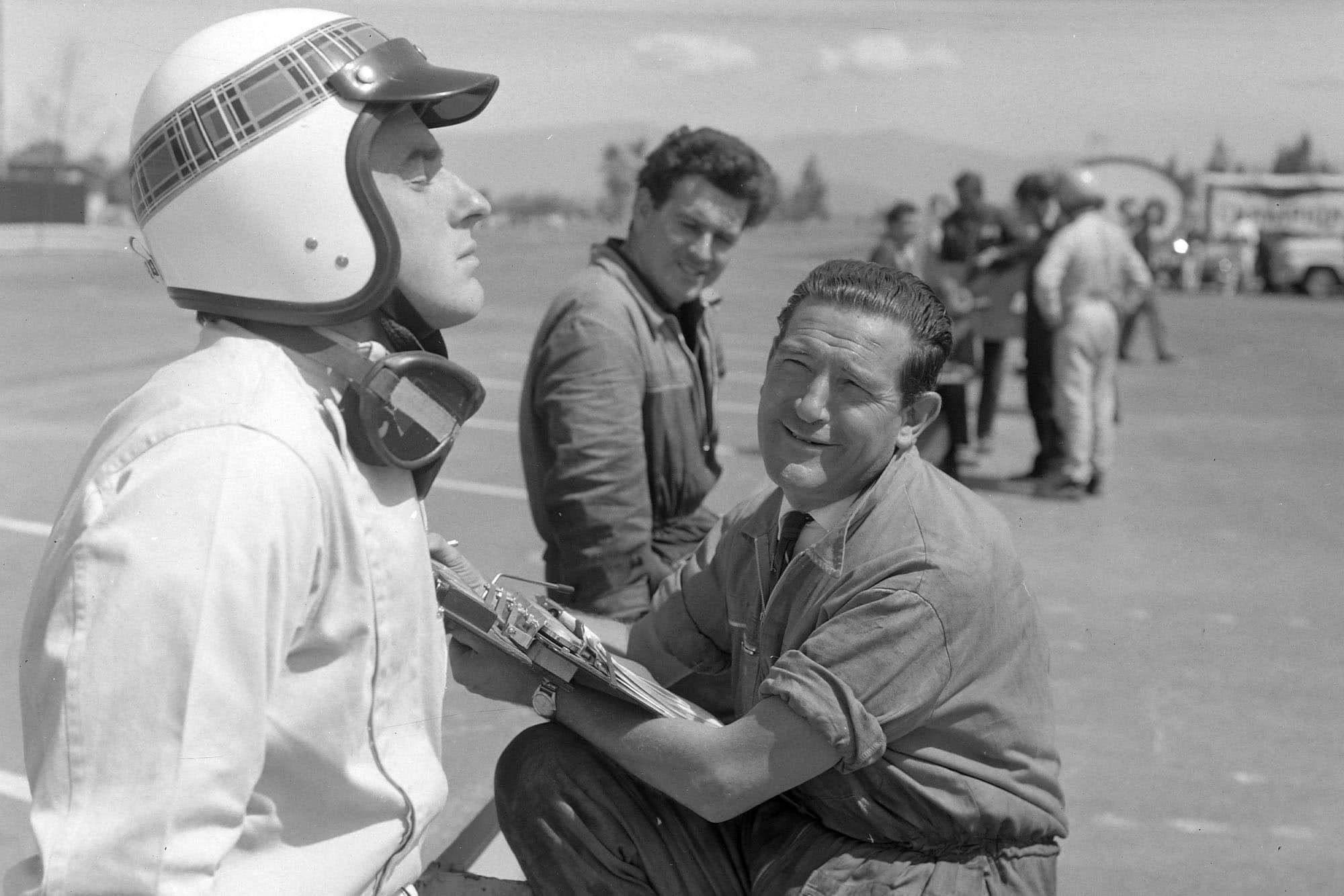
Stewart visualises the lap before he heads out
Motorsport Images
For dry weather they fitted 7.00/12.50-13 rear and 6.00/10.50-13 front, Super Sport Indy tyres; these are almost like the slicks used in drag racing, with tiny deep slits let in. The wet tyres are the same size and called Super Sport GP. These have a much more pronounced tread pattern to disperse the water. The front tyres have about 1.5in wider tread and look even squatter than the 13in Dunlops when they came out. Next year Firestone, Goodyear and Dunlop will be on the starting line of all Championship Grands Prix.
BRM had their usual three cars for Hill and Stewart, which, except for the weak mixture cams, were unaltered. Brabham had two cars for himself and Gurney. The latter was not using a 32-valve Climax due to the unreliability of this engine in the Brabham all through the year, and the mechanics were hoping not to have to make an engine change on the night before the race. The two Coopers for McLaren and Rindt were unaltered and the New Zealander was driving his last race for Coopers as next year he will run his own cars.
“Honda were taking this last race of the present Formula much more seriously than some of the other teams”
The Honda team were taking this last race of the present Formula much more seriously than some of the other teams. Bucknum and Ginther were out for special early morning practice sessions from 6 to 9 o’clock each morning, on the three days before official practice started. As this was their first appearance at the Mexican circuit they had many mixture problems to work out, plus the fact that their complicated fuel injection was giving trouble.
However, on the Thursday morning, with a damp track, Ginther was timed unofficially at 1min 58sec, which was faster than the record, although not so fast as last year’s fastest practice time of 1min 57.24sec. The two ears being used were a normal car as run at Monza and Watkins Glen for Ginther, While Bucknum was in the longer car with built-in torque absorbers in the hubs.
Walker had his two ears for Bonnier and Siffert. This was the last race in which Walker ran two cars, as next year he will be running a Cooper-Maserati for Siffert. Unlike Some of the other cars in this race, which will now be so-much scrap metal, the two dark blue Brabhams are becoming film stars, having been bought by Warner Bros. for Steve McQueen to drive in a multi-million pound epic which is planned. The Parnell team had both their cars in identical trim to Watkins Glen for Ireland and Attwood.
Qualifying
All cars and drivers were out at the circuit for Friday’s 4-hour practice session, starting at 1300hrs, and sharp on time Randini led off on a dry track in bright sunshine with a cool breeze. Hill’s BRM was sounding very rough and after only a few laps he was in having the mixture altered. Stewart was feeling slightly under the weather and his car was feeling flat. Clark was running his 32-valve engine quietly for some laps to bed it in properly.
While the two Lotus team drivers were not hurrying in the first hour, Solana was out to show his countrymen that his dismal display at Watkins Glen was because he was homesick, and after an hour’s practice he was the fastest Lotus and fourth overall. The first car to get under 2min was Gurney’s, followed by Ginther and Hill, whose mixture problem was quickly rectified.
Rodriguez was unable to say whether he thought that the Firestone tyres were better or not, and before he had time to really evaluate them he lost a rear wheel and crashed, without injury although the car was quite badly damaged. Bandini’s Ferrari had its exhaust megaphones changed to shorter ones and on the subsequent laps he slid up the slight banking on the turn before the pits and hit the safety rail hard, breaking the flange on the front wheel, but not causing any other damage.
Coopers were in after only a short run to change ratios, while Attwood had his BRM engine break before he had completed three laps. A dog which makes its appearance here every year trotted across the track in front of Bandini who was doing a few laps in Scarfiotti’s car.
Honda’s were clocking some very good times and, as has now become practice, their drivers swapped cars for a few laps, and again they both proved faster in the opposite cars. The consistency of their times in the 1min 57 or 58sec bracket and the fact that all other drivers were referring to being blown off down the straights indicated that the team were more than somewhat prepared for this race.
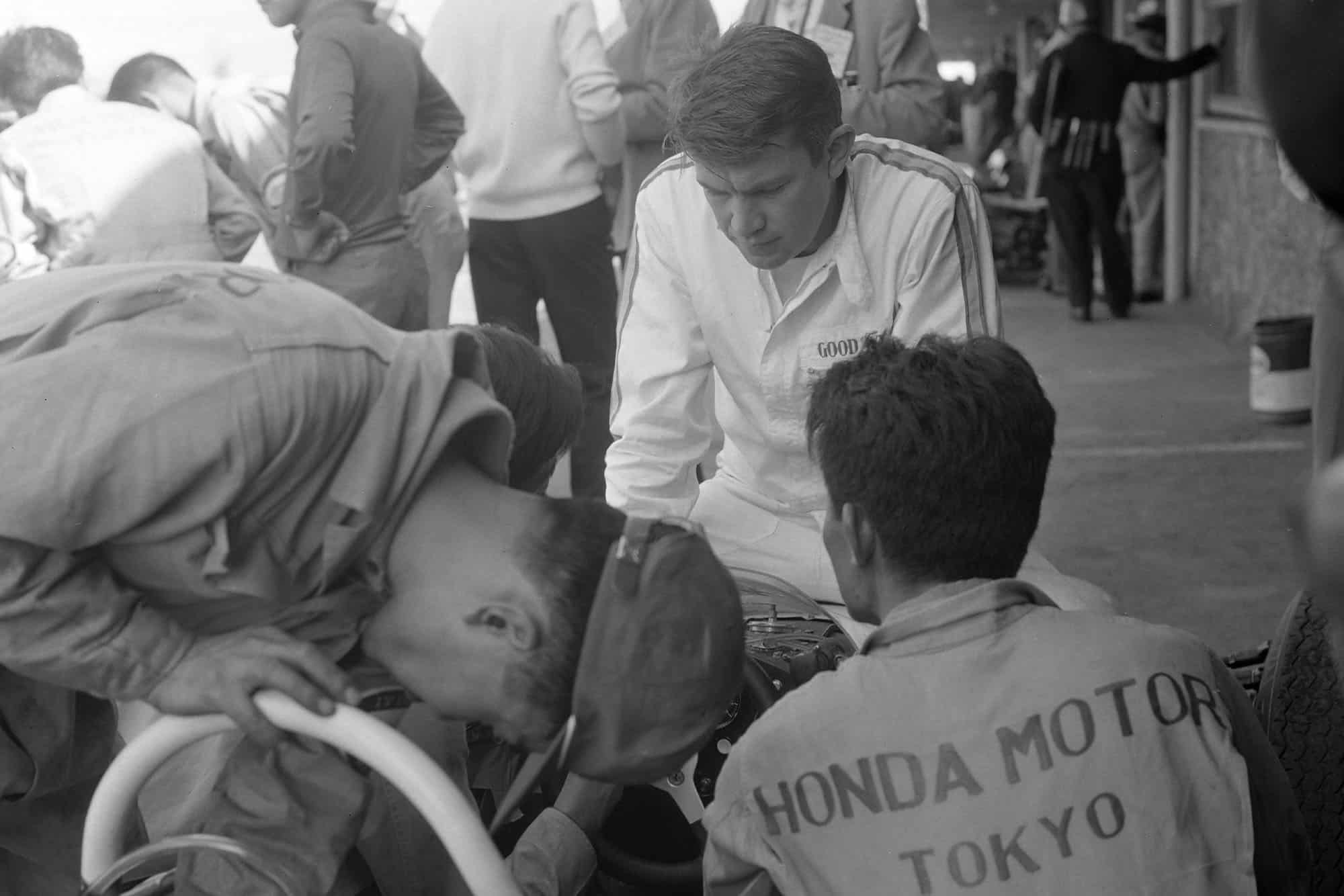
Honda had put a great deal of preparation into this high-altitude test
Motorsport Images
Clark was beginning to go very fast and was under 1min 57sec when his engine blew up in a cloud of smoke at the end of the straight. Contrary to expectation, neither he nor Chapman were the least bit sorry that the 32-valve engine was blown up as now they could fit an “old nail” (a 90′ V8 used last at Clermont Ferrand when the 32-valve failed there) which would not cause the anxiety that the more modern engine does. Just after Clark’s car blew up Brabham went past the pits spluttering, and stopped down the straight to be pushed back to the pits with empty fuel tanks.
BRM were not too happy for Hill’s Car was down on power and Stewart had blown his engine up in a big way. Clark went out in Spence’s car and recorded a faster time than in his own car with the latest engine. His time was only two-hundredths of a second slower than Gurneys fastest lap. Rindt stopped with a broken petrol pipe, having set a time of half a second faster than McLaren. Practice finished on time, with a lot of work to be done in the pits.
“BRM were not too happy for Hill’s Car was down on power and Stewart had blown his engine up in a big way”
Saturday was again bright and sunny, and the two snow-covered peaks of Ixtlacihuatl and Popocatepetl were clearly visible in the distance. Rodriguez’s car was still in pieces and the damage was proving more difficult than at first anticipated. Clark, Stewart and Attwood all had new engines, the Team Lotus No 1 car reverting back to look as it did, more than a year ago with the high centre exhausts.
Right on time again, with no filming or such distractions, Clark set oft to bed-in his engine; followed by Stewart, Spence and Hill. Spence was very soon into the swing and was down to 1min 58 sec. very quickly. however, with an increase in air temperature over the previous day it was doubtful if many cars would go faster unless it became cooler just before the end of practice at 5pm. Again the Hondas were sounding very good and were consistently lapping at 1min 58sec. Hill was complaining even more that there was no power in his car, while both Brabharns were lapping at under 2min.
A small drama was developing at the other end of the pits. The two Parnell drivers and the two Cooper drivers had failed to turn up at the beginning of practice. Tim Parnell and John Cooper got more and more worried as time went on, and when they were an hour late it was decided they must be inside Mexican jail.
“The two Parnell drivers and the two Cooper drivers had failed to turn up and when they were an hour late it was decided they must be inside Mexican jail”
Parnell was requiring Attwood’s car to be run as soon as possible as it had a new engine and might need tuning, so after waiting over an hour he got Bondurant, who was without his Ferrari drive, to take the car out for a few laps. At 2:30pm the four drivers appeared, having started late and then got lost on the way; hot words flew and Parnell sacked Ireland on the spot, although it wasn’t his fault, and gave his car to Bondurant to race, while the other three drivers were left in no uncertainty as to the requirements of a driver.
Honda once again swapped cars, and once again they were quicker out of their own cars. Rodriguez was unable to take out his own car and used Scarfiotti’s for a number of laps. Once Coopers got going they started having more troubles. The gear ratios were again changed, and a lot of work was being done to try and stop water pumping itself out of the overflow due to pressurisation of the cooling system. Just when they were getting sorted out McLaren was missing; he had the left front ball joint break and as the upright turned under braking, the caliper bridge-pipe was pulled off and the car, with hardly any brakes, steered itself into a guard rail, slightly buckling the wishbones.
As practice neared its conclusion there was the expected burst of activity. Clark, in particular, seemed set on wresting pole position away from Gurney, and with only minutes to go he succeeded with a time of 1min 56.17sec, a speed of 155.331kph, once again proving that he is the rightful World Champion. Stewart was also trying for a quick lap, even though he was running a temperature of 103f and feeling groggy. As the BRM came round the slightly banked last turn something suddenly gave on the left front suspension. Closer examination discovered that the bracket on the monocoque which holds the lower link had partly pulled away, and as this would be a major repair job it was decided to use the spare car with the engine from the damaged car.
Race
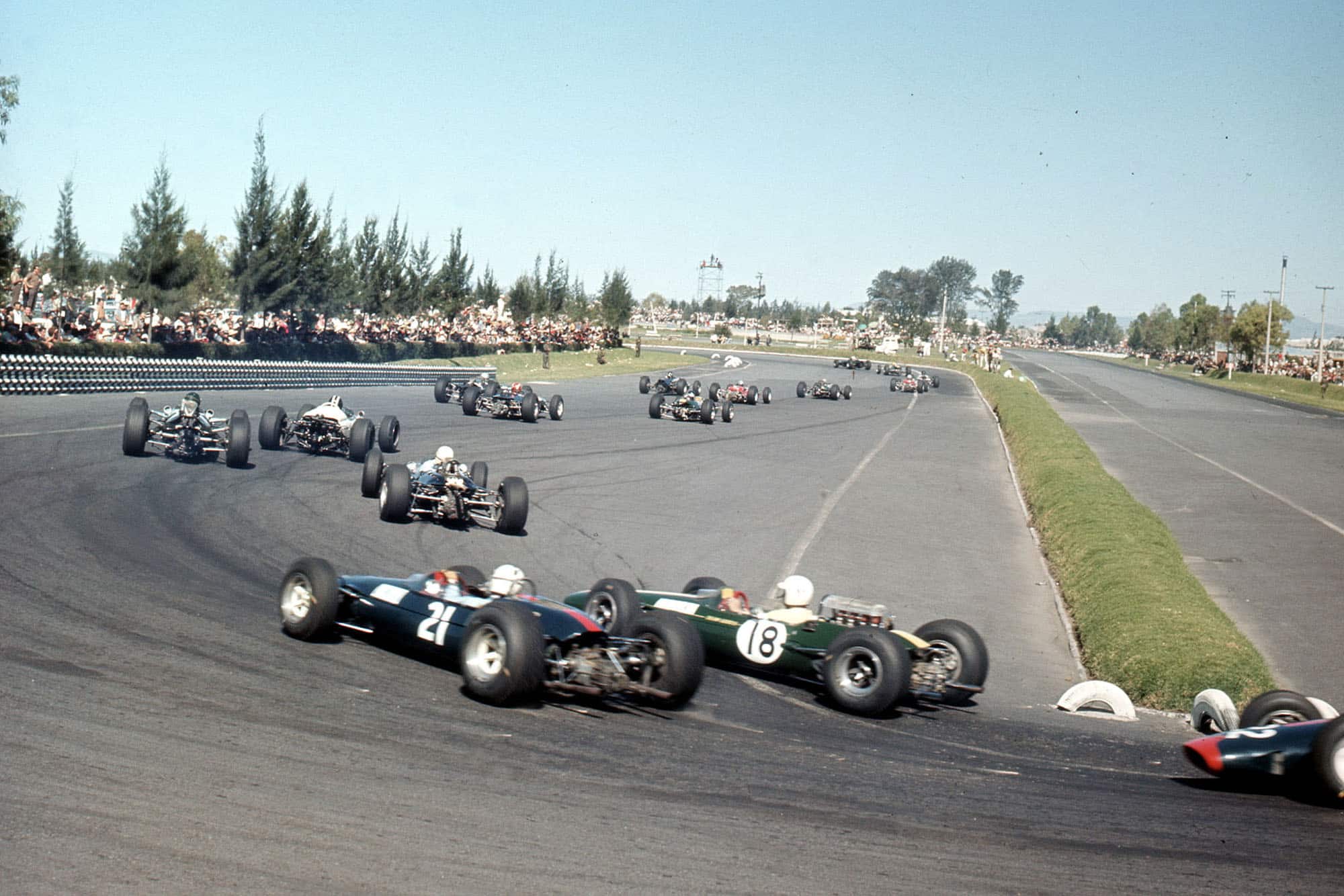
The field threads through the hairpin on the opening lap.
Motorsport Images
Race day was fine and sunny and after two saloon car races in the morning, the serious business of the day began. Rodriguez’ car was not ready so he took over Scarfiotti’s car, which meant only 17 starters and a re-shuffle on the grid. Hondas had switched numbers on their cars, putting Ginther on the second row of the grid. Stewart’s car was in fact the training car, with his practice engine fitted.
Before the start the drivers were supposed to parade, in single file behind a pace car; in the Renault R8 1100s which each had been supplied with. Instead of waiting for the procession to start, most of them rushed off for a Renault GP round the circuit. In tight bunches, taking short cuts, driving in the opposite direction and doing hand-brake turns, the procession turned into a gymkhana. One driver only behaved in the gentlemanly manner the organiser’s were expecting, and this was Jim Clark, who tried to comply with the laid-down plan.
“Gurney and was in the lead by the first corner…halfway round the lap and he was already 50 yards in the lead from Stewart”
After a warming-up lap the race started on time. From the drop of the flag it was Ginther all the way. With the extra power he had he swept past Clark and Gurney and was in the lead by the first corner. Halfway round the lap and he was already 50 yards in the lead from Stewart, who had made a very good start. At the end of lap one, Ginther led from Stewart, Spence, Gurney; Hill and Rodriguez. Then a short gap and McLaren came with Siffert, Clark (who made a bad start and whose engine was not pulling properly), Rinds, Bonnier, Bucknum and Solana. Bringing up the rear were the two Parnell cars of Attwood and Bondurant.
As the field swept off into the second lap Brabham came into the pits with a rocker box gasket leaking. It took six minutes to fix this, but he made another pit stop on his third lap. as his oil pressure was surging due to the amount he lost on lap 1. Meanwhile Ginther was still pulling away and at the end of lap 2 his lead was 100 yards from Spence who had passed Stewart and was pulling away from the next four, Stewart, Gurney, Banditti and Hill. McLaren dropped two places on lap 2, when he was passed by Siffert and Clark. The other Cooper was passed by three cars on the second lap, these being Bonnier, Bucknum and Solana. Attwood and Bondurant were keeping close formation at the rear.
In the next few laps Ginther pulled away from Spence, and the Lotus away from the next group. Hill passed Bandini on the fourth lap, and Stewart, Gurney and Hill then pulled away fighting hard for third place. On the seventh lap Hill passed Gurney and on the next lap they both passed Stewart, whose clutch was beginning to slip.
Bandini, once he lost the two BRMs and the Brabham, chopped back and was challenged straight away by Rodriguez, Siffert and Clark. Siffert passed the Mexican on lap 5 only to be passed by both Rodriguez and Clark on the next lap. McLaren and Bonnier were dicing for 11th place and on lap 6 the Cooper dropped back and was passed on the next lap by Bucknum, who closed right up on Bonnier’s tail. McLaren now found himself just ahead of Rindt and they held the team formation for some laps. On the eighth lap Clark’s engine stiffened up and there was a ” funny ticking noise ” coming from it, so he stopped near the hairpin and retired.
Ginther was still holding a lead of 4.2sec over Spence who, in turn, was 5sec, ahead of Hill and Gurney. By the 11th lap Stewart had dropped away from his team mate and the Brabham driver; the latter made two efforts to pass Hill in the hairpin and on the third attempt he was through, so on lap 12 Gurney was third and setting out in a very determined way after Spence. Hill held fourth with Stewart fifth, about 3sec behind, and 7sec behind the BRMs the two Ferraris were having a dingdong battle for sixth place. Bandini held Rodriguez off for some laps but on the 54th lap the Mexican got past, to the delight of the patriotic crowd. Over the course of the next 12 laps they changed positions several times, keeping very close together. Siffert was lying eighth and keeping the two Ferraris in sight. Behind him was his team mate, Bonnier, also holding his position.
Bucknum and Solana were mixing it and the more powerful Honda got past the Lotus on lap 9, but Solana was getting into his stride and five laps later the Lotus re-passed the Honda and the Mexican went after Bonnier, eventually passing him on lap 18. As Clark retired, Bondurant passed Attwood for three laps before being re-taken and pushed back into the last but one position: The last place was still held by Brabham, who was several laps. down.
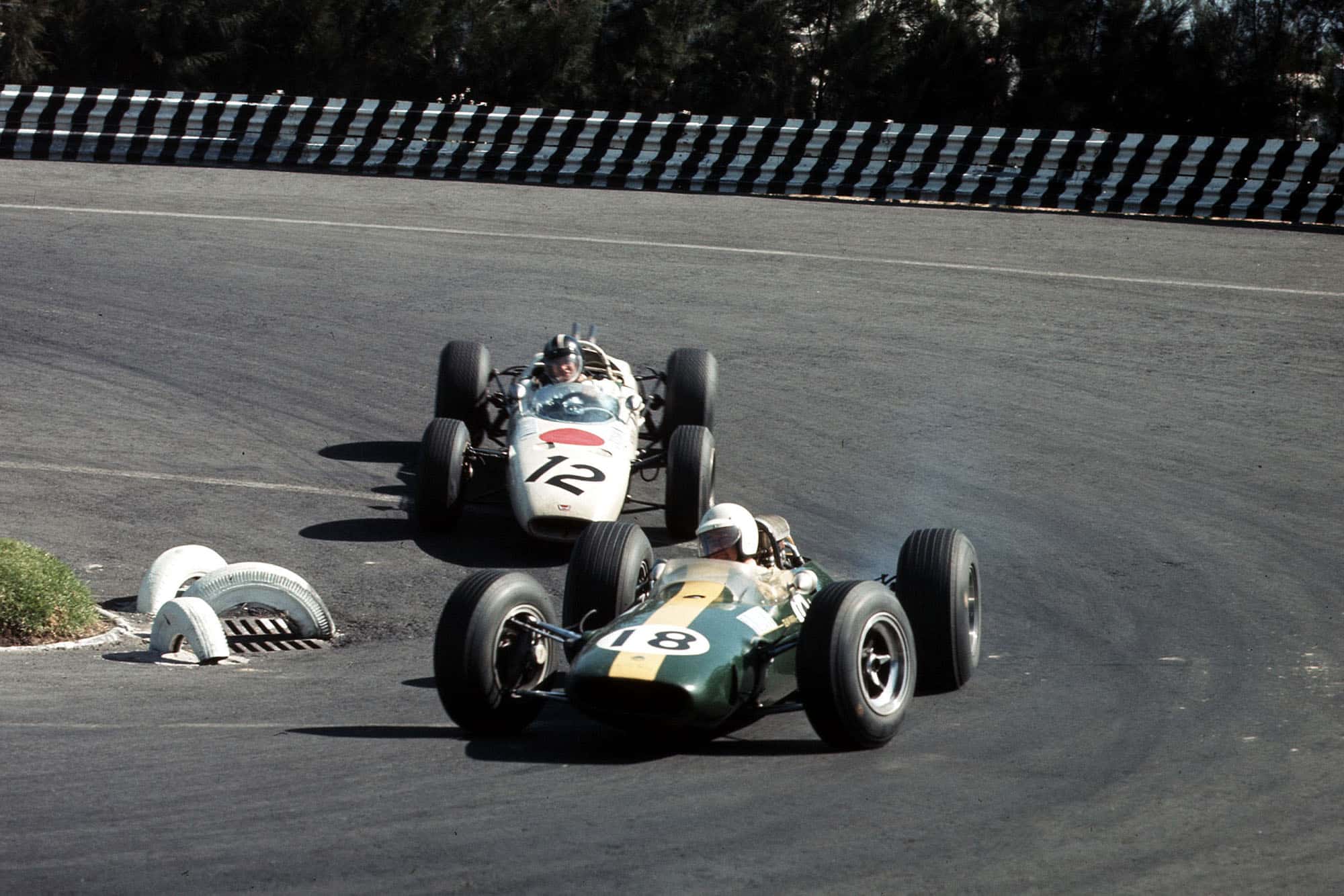
Bucknum chases Solana
Motorsport Images
The Cooper pair switched places on the 14th lap. They continued in convoy for some time until McLaren’s gear selectors broke and he retired on lap 25 just as he was passed by Attwood. Stewart’s slipping clutch was becoming noticeable and Rodriguez caught and passed the BRM on the 28th lap, only to be re-passed two laps later when the clutch gripped again. On lap 29 Bondurant retired from last but one place when a bolt on the lower right-hand rear upright broke and the car slewed off the track.
“Drama hit the Ferrari team. Bandini got sideways on and ripped the nose of his car off against the rubber tyres which marked the corners”
The halfway mark was approaching and still Ginther was well in the lead, with Gurney making no impression on him. Then drama hit the Ferrari team. Bandini got sideways on and ripped the nose of his car off against the rubber tyres which marked the corners. He went to the pits on lap 33, where by chance there was a spare nose-shell with his number on it, sitting waiting for just this moment. While he was in the pits in came Rodriguez with a badly running engine. The Mexican’s trouble was that the rectifier was faulty and the battery had gone flat. Quickly a new battery was fitted and Rodriguez was out again behind Bandini in last but one position.
Siffert caught the sickening BRM and on lap 34 he passed Stewart into fourth place. Stewart’s clutch had by now nearly had it. On lap 35 Bucknum and Solana passed him, and on this lap he pulled into the pits and after a brief examination he retired. Pressure at the front now became tremendous for Gurney was pulling out everything he knew and Ginther was equalling his times, so the gap of about 7sec at the halfway stage had only crept down to 4sec in 20 laps. Rindt’s Cooper suddenly cut as he went past the pits and he parked the car just beyond. The ignition had cut when the electrics failed.
* * *
A short while later, on lap 43, Bonnier slowed, letting Attwood and Bandini pass, and on the next lap he retired when the bracket of the lower front suspension link broke away from the chassis. Solana was still catching Siffert and on lap 49, following a time of 1min 57.60sec, he passed into fifth place. Things now looked all set for the finish. However, the 1965 Mexican GP still had a sting in its tail. On lap 55 Moises Solana’s race came to an end when the transistor box on his Lotus packed up suddenly, and he retired from a certain fifth place. Next lap Hill felt the engine beat slow slightly. and then the engine went bang, wrecking it internally.
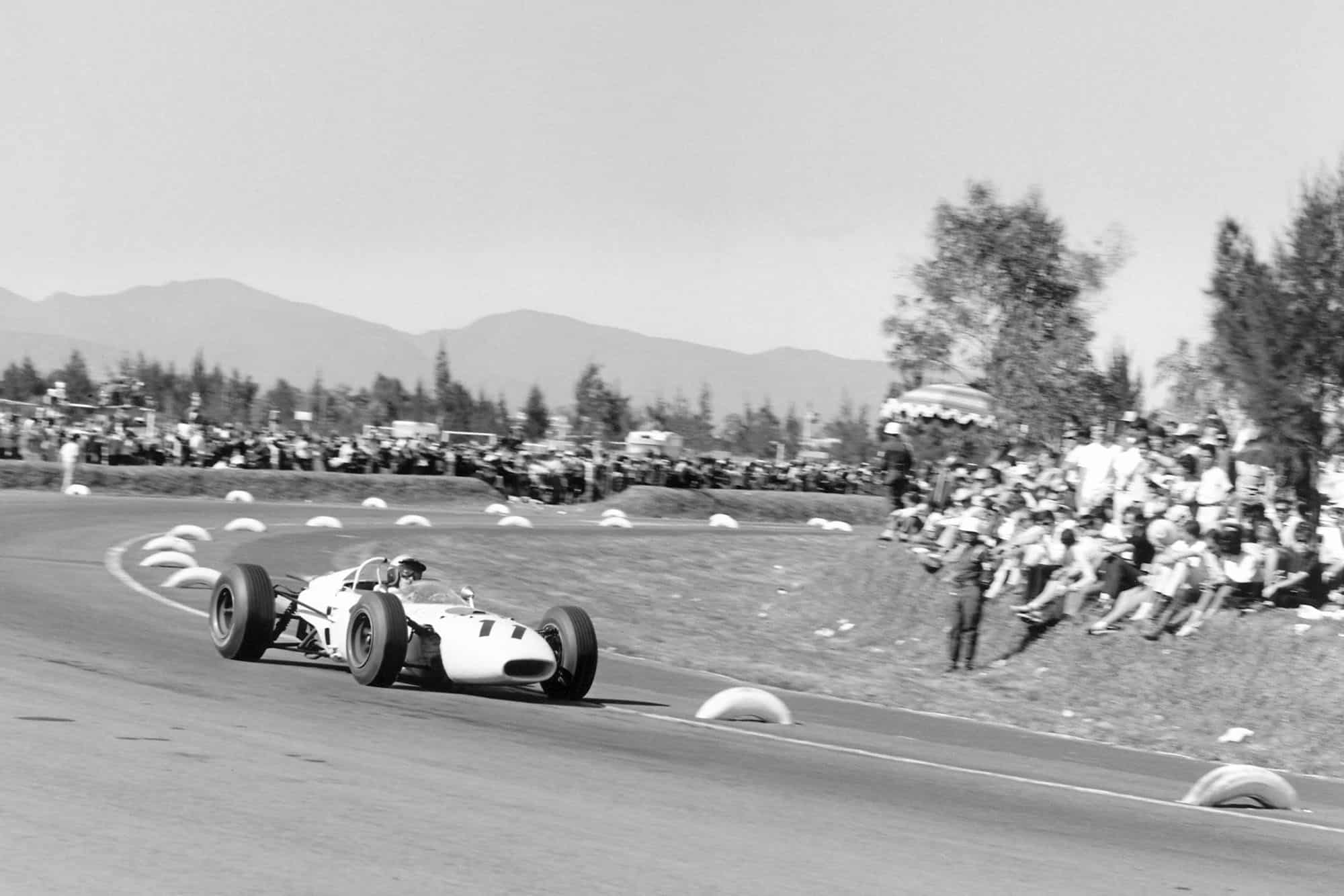
Despite late pressure from Gurney, the race belonged to Ginther
Motorsport Images
The speeds of the leading two cars were creeping up every lap, as Gurney closed on Ginther and the Honda driver did all he could to keep the gap open. With both drivers lapping faster than in practice the lap record fell several times, finally settling on Gurney with a time of 1min 55.84sec, a speed of 155.440kph. The final laps ticked away and the Honda crossed the finish line 2.89sec, ahead of Gurney’s Brabham.
In third place came Spence, 1min 00.15sec behind Ginther, and on the same lap just behind him came Siffert in a time of 2hr 10min 26.52sec. One lap down came Bucknum and Attwood, in fifth and sixth places, while the last two cars running were the two Ferraris. Rodriguez passed Bandini on the last lap when the Italian car slowed right down through lack of coolant in the engine.
The Mexican Grand Prix raised several interesting points. It was the last event in this Formula; it was won by Honda getting their first Championship win; it was won by Ginther getting his first Championship win; Goodyear tyres were first and second (the Dunlop monopoly was broken at last); the latest Climax engine wasn’t any good—it was almost as if the Coventry firm had retired already.
